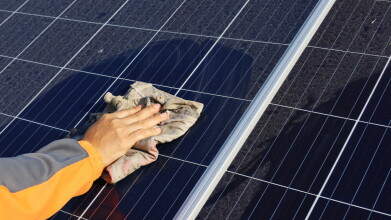CEMS
How renewable electricity could increase carbon emissions
Nov 13 2024
Another year, another COP. This time, we're in Azerbaijan - and almost immediately, that became a problem. As reported by The Times, President Ilham Aliyev referred to fossil fuel resources as a 'gift from God' in his official address to the conference's delegates, going on to claim that:
countries should not be blamed for having [oil and gas] and should not be blamed for bringing the resources to the market, because the market needs them.
For anyone following the energy transition at all closely, the immediate reaction is not horror, but shock: doesn't he know that he's betting on a dead horse, that renewables are far, far cheaper? But this seemingly bizarre moment, where the president of the nation hosting the global coordinating committee for the transition away from fossil fuels uses his address to encourage the use of those same fuels, may actually be the most accurate summation of how decarbonisation is currently going.
Cheaper renewables means cheaper fossil fuels
In 2020, research charity Our World in Data published an investigation into the rapid cheapening of renewable energy relative to fossil fuels for electricity generation.1 Using the Levelized Cost of Energy (LCOE), a comprehensive measurement of the cost per unit of energy generation (including financing costs and factoring in the different lifetime of assets, but not the costs of storage), to compare the different energy sources, Our World in Data found that the cost per unit using solar photovoltaics (PV) dropped by 89%, making it cheaper by almost a third (28.5%) than the next cheapest fossil fuel source, combined cycle natural gas. For electricity generated by onshore wind, costs decreased by 70% in the same period to levels just above solar PV, rendering it cheaper by a little more than a quarter (26.8%) compared to combined cycle gas. But it's even more astonishing than that. For generating electricity, onshore wind and solar PV are two-thirds (62.4%) cheaper than coal power and three-quarters (76.5%) cheaper than natural gas peaking.
Great news, right? Well, let's think a little bit more about how these price reductions might play out in an energy market.
If you're a business or a household in an area served by electricity companies with access to renewables, your provider only has to use a little bit of wind or solar to lower their prices - in effect, using renewables to subsidise the price of carbon-intensive electricity. Adding renewables to their fuel mix makes it possible for your provider to sell you more megawatt-hours for the same price, even if they generate some of that extra electricity using fossil fuels. What's more, as a consumer (and especially as a business), you're unlikely to leave all of that newly-affordable extra energy on the table. This way, it's possible to fully capitalise on remaining carbon-intensive assets whilst 'decarbonising'! So, you consume more megawatt-hours for the same price; you're happy, energy companies are happy - and carbon emissions go up.
This is a textbook example of the Jevons paradox, which suggests that the decreases in price brought by increases in the efficiency with which a resource (including an energy resource) is consumed tend to actually accelerate the consumption of that resource. Now, if renewable energy were used for entirely unique forms of power that fossil fuels were incapable of generating, we wouldn't have to worry all that much about this increased consumption, except for concerns over minerals and other materials. But as things stand, the use of renewable energy is helping to drive down the price and increase the consumption of carbonised elecricity.
The grid isn't fussy
... the contours of a new, more electrified energy system are becoming increasingly evident...2
When you think of the low-carbon future, what sort of things do you picture? My guess: an electric car. If not, maybe you'll summon a heat pump, an induction hob, or an electric arc furnace. But the electricity powering all of these 'green technologies' could be generated using coal or natural gas, and you'd be none the wiser.
Nevertheless, electrification is the name of the game in this first phase of the energy transition - and it's not just end-products that are being electrified. With all of its hype, green hydrogen is produced through electrolysis - although, for the time being, steam methane reforming is the norm, so Big Carbon wins either way. In other words, even if Honda's bet that hydrogen fuel cells will usurp batteries for EVs or BP's that hydrogen is the fuel of the future come off, this will be no guarantee that the company will have actually decarbonised.
It's worth translating all of this into some clear numbers.
According to the IEA, energy demand grew 15% between 2013 and 2023,3 but 'Electricity use has grown at twice the pace of overall energy demand over the last decade,' i.e. an increase of 30%.3 4 Now, consider that Our World in Data's report on falling renewables prices is already itself four years old (December 2020), that it was investigating rapid price falls that were widely believed to be imminent a decade before that and that were both cheaper than coal by late-2017, with onshore wind outcompeting coal in the early-2010s. So, let's say we're about 15 years' deep into the energy transition - what do we have to show for it? Well, to be perfectly blunt: the release of about a quarter of all emissions in history (since 2008). That's equivalent to about 50 years' worth of 20th century emissions. In summary, over the period of the green transition so far, we've seen the fastest rise of carbon emissions in history.5
But aren't we over the hump now? Aren't emissions expected to peak soon? Well, let's take a look through the International Energy Agency's annual World Energy Outlook for 2024, where you'll find the original versions of these claims. Casting an eye back over the transition so far, the IEA report that:
The last decade has seen the share of fossil fuels in the global energy mix gradually come down from 82% in 2013 to 80% in 2023. Demand for energy has increased by 15% over this period and 40% of this growth has been met by clean energy, i.e. renewables in the power and end-use sectors, nuclear, and low-emissions fuels, including carbon capture, utilisation and storage (CCUS).3
The implication of these findings, of course, is that 60% of that energy growth has been in fossil fuels - and the IEA's latest data for 2023 alone reflects this split almost exactly, with only a third of new energy last year being green.4 What's most revealing, however, is the following section:
Electricity demand growth is set to accelerate further in the years ahead, adding the equivalent of Japanese demand to global electricity use each year [...] and rising even more quickly in scenarios that meet national and global net zero goals. The projections for global electricity demand [...] are 6%, or 2 200 terawatt-hours (TWh), higher in 2035 than in last year’s Outlook, driven by light industrial consumption, electric mobility, cooling, and data centres and AI.4
When will the energy transition take place, then? If it's clear that there's no evidence on a global scale so far that adding renewable electricity will do much more than slightly dilute greater consumption of fossil fuels, what's to prevent all of this new infrastructure from giving fossil fuels a second wind?
By electrifying the global economy and adding massive quantities of cheap renewable electricity when it is still both legal and profitable to continue burning fossil fuels, all we're doing is incentivising the consumption of fossil fuels. And just like with climate change itself,6 7 it seems that the fossil fuel industries are ahead of the game.
Big Carbon bets on the Jevons paradox
.. action is needed to accelerate the transition. And – at the same time – action is needed to make sure that the transition is orderly, so that affordable energy keeps flowing where it’s needed today. [...] We are growing our investment into our transition and, at the same time, growing investment into today’s energy system. In doing so - we see tremendous opportunity to create value. And it’s what governments and customers are asking of companies like us.8
On a global scale, there is no evidence of anything even approaching divestment from fossil fuels. In fact, the opposite appears to be true.
In 2023, German research group Urgewald published its findings that 96% of the 700 upstream oil and gas firms that it investigated were 'still exploring or developing new oil and gas fields.'9 According to Urgewald, the biggest investors were (in descending order): China National Petroleum Corporation, the multinational CNOOC International, Saudi Aramco, Mexico's Pemex, China's Sinopec Group, ExxonMobil's Pioneer Natural Resources, and the UK's Shell. But they're all on the list, Gazprom, Petrobras, TotalEnergies, BP, Eni - the list goes on. This includes big investments in LNG export infrastructure, in conformity with the IEA's claim in its latest World Energy Outlook that an increase of 'nearly 50% of global LNG export capacity is on the horizon' (Urgewald's report claims the planned increase is over three times larger, around 160%).3 Given that LNG is the world's second-most major source of electricity - according to global energy think tank Ember, it accounted for 23% of global electricty generation in 2023, with coal in pole position with 35% - it seems that the industry isn't contracting with the death of gas boilers or hobs, it's preparing to supply heat pumps and induction cooking with all of that LNG instead.10
China's development over the last decade is emblematic, accouting for two-thirds of the global increase in electricity demand over that period.4 In 2023, Reuters reported that China was still generating '70% of its electricity from fossil fuels, mostly coal'.11 Another Reuters report from 2023 stated that 'renewable generation is not growing fast enough to meet growth in consumption, let alone reduce the need for coal.'12 Finally, one year later, Reuters reported in recent months that 'the amount of electricity from coal is still rising' and that 'the world's biggest coal producer and importer is likely to mine and buy even more coal.'13 All of this despite China being the completely unchallenged world leader in wind and solar for sheer gigawatts. By comparison with the US, China's renewables generate it 30% of electricity but in the United States, it's 16.6%.14
According to Statista, the US has 289.7 GW of installed solar and wind capacity.15 Whereas there are reports that China is on track for 1,200 GW by the end of 2024 - in this same report, by the way, the authors claim that some Chinese energy officials have 'argued' that a 'postponed peak' of carbon emissions (the current target is "before 2030") could 'avoid early sunk costs from the coal power industry', which follows directly the dynamic sketched earlier.16
Nevertheless, at a UN General Assembly in 2020 during the COVID-19 pandemic, President Xi Jinping announced a commitment to carbon neutrality by 2060. One year later at another Assembly, it was announced that China will 'not build new coal-fired power plants abroad' as part of its massive Belt and Road Initiative (BRI) and will begin its phasing-out of coal power domestically after 2025. Whilst this is promising, it is possible that we'll see a sustained plateau, as opposed to a sharp peak, in China's emissions as it continues to capitalise its coal assets both domestically and abroad - that is, if these commitments are honoured. It remains to be seen, however, whether that peak is imminent.
Put simply, there are deep problems with the strategy of decarbonisation through renewables alone. What these problems imply is that further measures must be considered to limit either the supply of or the demand for fossil fuels, measures like annual rising carbon taxes, fully-enforced bans on new exploration and development of fossil fuel resources, sectoral energy quotas, and parallel incentives to stop burning fossil fuels, like Chen, van der Beek and Cloud's global carbon reward currency from 2015. Whilst it's perfectly possible that renewables will effectively decarbonise electricity generation without these extra measures, there are reasons to doubt that this is guaranteed.
1 Roser, Max. Why did renewables become so cheap so fast? Our World in Data. 2020:
2 Dr. Birol, Fatih. World Energy Outlook 2024. Foreword. October 2024. International Energy Agency (IEA). pp. 3.
3 Cozzi, Laura et al. World Energy Outlook 2024. October 2024. International Energy Agency (IEA). pp. 18, 24.
4 Executive Summary. World Energy Outlook 2024. October 2024. International Energy Agency (IEA).
5 Ritchie, Hannah and Max Roser. CO₂ emissions: How much CO₂ does the world emit? Which countries emit the most? Our World in Data. 2020.
6 Hall, Shannon. Exxon knew about climate change almost 40 years ago. Scientific American. 2015:
7 Franta, Benjamin. What Big Oil knew about climate change, in its own words. The Conversation. 2021.
8 Looney, Bernard. bp Integrated Energy Company strategy update: Growing investment, growing value, growing distributions. 7 Feburary 2023:
9 Bartsch, Nils. The 2023 Global Oil & Gas Exit List: Building a Bridge to Climate Chaos. 15 Novemeber 2023: https://www.urgewald.org/en/medien/2023-global-oil-gas-exit-list-building-bridge-climate-chaos
10 Ember. Yearly Electricity Data. 2024.
11 Howe, Colleen. Explainer: The numbers behind China's renewable energy boom. Reuters. November 15 2023.
12 Kemp, John. China’s renewable boom can't keep pace with power demand. Reuters. October 26 2023.
13 Russell, Clyde. China's coal use and output are rising, even as renewables surge. Reuters. September 18 2024.
14 United States Energy Information Administration (EIA). Electric Power Monthly. August 2024.
15 Fernandez, Lucia. Renewable energy in the U.S.: Statistics & Facts. November 4 2024.
16 Yu et al. China continues to lead the world in wind and solar, with twice as much capacity under construction as the rest of the world combined. Global Energy Monitor. 2024.
Digital Edition
AET 28.4 Oct/Nov 2024
November 2024
Gas Detection - Go from lagging to leading: why investment in gas detection makes sense Air Monitoring - Swirl and vortex meters will aid green hydrogen production - Beyond the Stack: Emi...
View all digital editions
Events
Nov 26 2024 Paris, France
Nov 27 2024 Istanbul, Turkey
H2O Accadueo International Water Exhibition
Nov 27 2024 Bari, Italy
Biogas Convention & Trade Fair 2024
Nov 27 2024 Hanover, Germany
Dec 02 2024 London, UK











.jpg)







